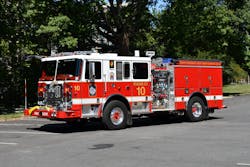The Apparatus Architect: District of Columbia Fire and EMS Department Apparatus Fleet
Providing fire and EMS protection to the U.S. Capitol is the responsibility of the District of Columbia Fire and EMS Department (DCFEMS). Its roots trace back to April 1864, when the U.S. Congress authorized the formation of a paid fire department. The department was reorganized in 1871, with the response area expanded to begin the era of a full career organization.
Today, the DCFEMS is under the command of Chief John Donnelly Sr., who oversees department operations and personnel who staff 33 fire stations.
In 2022, the DCFEMS responded to more than 409,000 incidents, approximately 75 percent of which were for EMS-related calls. The DCFEMS operates with 33 engine companies, 16 truck companies, 3 heavy rescues and a two-piece hazmat unit, along with 43 BLS and ALS transport units. Engine Company 10 and Engine Company 30 are among the busiest units, responding to more than 6,000 calls annually. Four ladder companies, including Trucks 8, 13, 16 and 17, each handle more than 4,000 annual incidents. This level of activity, when combined with the ambulance responses (20 of the 26 BLS units cover more than 4,000 responses annually), requires a well-managed fleet program to ensure the readiness of all front-line and reserve apparatus.
Apparatus Division
The DCFEMS Apparatus Division is under the command of Deputy Chief Edward Rice, who is a 27-year veteran of the department. Rice has extensive experience in apparatus specifications, fleet maintenance and inspection practices and oversees the department’s fleet of 419 vehicles.
To provide apparatus that’s designed to meet the demands of the response area, the DCFEMS develops its own specifications for all new engine, ladder and rescue squad vehicles and utilizes a nationally recognized purchasing consortium as the contracting agency for each fiscal year’s purchases. Ambulance vehicles are similarly specified to meet the department’s needs, using a local Council of Governments contract.
The planned life cycle for engines is six years front-line and five years in reserve; the planned life cycle for truck companies is eight years front-line and five years in reserve. The rescue squads are planned at an 8–10-year life cycle, with the goal to reduce this to seven years because of the high run totals for the rigs.
The DCFEMS spare apparatus fleet consists of 30 engines, 14 trucks, 2 rescue squads and 55 ambulance units. To meet these life-cycle time frames, the department annually seeks bid proposals from apparatus manufacturers to acquire a minimum of 6 engines, 2 tractor-drawn aerial ladders and 15 ambulances.
The DCFEMS utilizes a fleet software program to track all preventative maintenance,
warranty repairs and out-of-service time to monitor these events against the desired in-service time benchmark of 75 percent. Because of the fleet size, 40 personnel are assigned to the Apparatus Division. The parts room is managed by an outside contractor.
Post-pandemic supply chain issues have affected the department, but standardized components that are specified on each type of apparatus minimize this to some degree.
Maintenance
Preventative maintenance is conducted on all vehicles based on A, B and C schedules. Each schedule addresses particular areas and components on apparatus to enhance safety and reliability of the vehicles. The importance of maintenance and component reliability is stressed in the DCFEMS apparatus specifications, which are revised prior to each year’s bid-proposal cycle. Because the department’s funding comes from District of Columbia funding, the time that’s required to secure bids and to process each order can be protracted. The current extended production times of the apparatus industry have affected the planned life cycle for the major pieces of apparatus.
Specifications
The DCFEMS is unique in that it authors its own specifications for each major type of apparatus and details its requirements for bid submissions, specific component models, part numbers and warranty requirements. Starting with basic apparatus dimensions (e.g., wheelbase, overall length, height. ground height, bottom of the crosslay transverse beds and rear hosebeds), this detailing ensures units are identical from year to year, depending on the vintage of the apparatus.
Within the engine company specifications, several requirements stand out as unique and might not be observed at first glance.
The dashboard is lowered to optimize windshield visibility. The air conditioning system has gravity drains. Fluid checks and battery change-outs don’t require cab tilting. Wiring harnesses that are between the cab and body are in flexible conduit. To reduce the effect of high-water conditions, the air cleaner is mounted high in the chassis.
Although apparatus OEMs have different versions for components that are utilized on a standard model build (e.g., axles, alternators, fire pump valves and running lights), component standardization is important. It enables critical components to be replaced with in-house parts, so items can be tracked for reliability and service time. The DCFEMS engine specifications address specific models for all fire pump suction and discharge valves and pull-rod and hand-crank controls, which are protected by rubber boots.
Access to and extended warranties for fire pump components, cab tilt and chassis system filters are addressed.
Often overlooked elsewhere in apparatus specifications is the effect of corrosion because of road deicing chemicals and other environmental conditions. Requirements here detail that the cab and body be fabricated from stainless steel. The frame rails, all chassis components, the fire pump and piping are painted job color.
Other components, including a chassis lubrication system and aggressive transmission downshift programming, are an integral part of the technical specifications.
Apparatus design characteristics that are more readily visible on the apparatus include a steel-reinforced front bumper; a front downview mirror; recessed side warning lights; heavy rub rail material along the body sides; Bustin nonslip material on step surfaces; and split door-open circuits.
Repairs
When developing vehicle specifications, the department details its requirements for bid-proposal submissions and terms of warranty coverage. The DCFEMS calls for a five-year bumper-to-bumper warranty and notes the difference between a critical repair and a noncritical repair. The former takes the unit out of service, and the manufacturer carries out the repair within 48 hours or advises that the repair can’t be accomplished within the time frame. In conjunction with the latter, the Apparatus Division advises the manufacturer of the issue, and the manufacturer provides a time estimate as to when the issue will be corrected.
For aerial ladder apparatus, DCFEMS specifications require that manufacturers are responsible for two annual preventative maintenance sessions and the annual aerial device testing that’s conducted by a third-party testing company. This makes the annual certification process easier, because there’s little room to dispute the results of the testing company and any issues that must be repaired to achieve certification.
In-process/final inspections
The DCFEMS developed a detailed final inspection document that follows the order of the specifications for each major piece of apparatus. This document captures the major component makes, models and serial numbers; validation of all critical dimensions; operational testing of all chassis, fire pump and aerial device components; and testing of the door-ajar system with the apparatus electrical system.
Other sections of the document concern the operational testing and recording of the results of the pump test, tank-to-pump-flow test, road test and braking system performance test; underchassis and cab-tilt inspection; and electrical system harness runs and securement. A water spray test to check the cab, cab roof and all body compartments for leaks is conducted. A roll-stability tilt table test and a review of all third-party testing certifications that were conducted prior to the final inspection by DCFEMS personnel also is carried out.
Strict criteria
The Apparatus Division maintains high standards in development of technical specifications and inspection practices. This ensures that apparatus meet the requirements in each area to enhance fleet readiness for each type of apparatus and support units.
Our thanks to Deputy Chief Edward Rice for providing information on the Apparatus Division and how it works to enhance the operational capabilities of the organization on a daily basis.
New Apparatus Inspections
An often overlooked part of the apparatus acquisition process is conducting in-process and final inspections on a new rig. The scope of these two categories of inspections and the work to be accomplished at each point must be detailed within the bid specifications that the apparatus committee creates. At minimum, this should include a compliance review of the entire vehicle and all components, a road test, a pumper service test, confirmation of all critical dimensions, and an operational test of all running and warning lights and auxiliary systems. Although reliance on a manufacturer’s testing documentation is a start, the expression of “Trust but Verify” is highly appropriate.
This is most important with respect to the verification of the in-service weight of the rig for comparison with other identical units in a fleet and the originally submitted weight analysis from the engineering conference. If your department desires to witness a tilt table test for compliance with NFPA 1900: Standard for Aircraft Rescue and Firefighting Vehicles, Automotive Fire Apparatus, Wildland Fire Apparatus, and Automotive Ambulances, this should be called out in the boilerplate of the specifications. This prevents surprises at the point of final inspection and allows the manufacturer to provide sufficient time and personnel to work with your department during the final inspection process.
About the Author
Michael Wilbur
MICHAEL WILBUR, who is a Firehouse contributing editor, retired as a lieutenant in FDNY, where he was last assigned to Ladder Company 27 in the Bronx. He has served on FDNY's Apparatus Purchasing Committee and consults on a variety of apparatus-related issues around the country. Wilbur is a member of the Firehouse Hall of Fame. For further information, access his website at www.emergencyvehicleresponse.com.

Tom Shand
TOM SHAND, who is a Firehouse contributing editor, is a 36-year veteran of the fire service. He works with Michael Wilbur at Emergency Vehicle Response, consulting on a variety of fire apparatus and fire department master-planning issues. Shand is a member of the Firehouse Hall of Fame.

